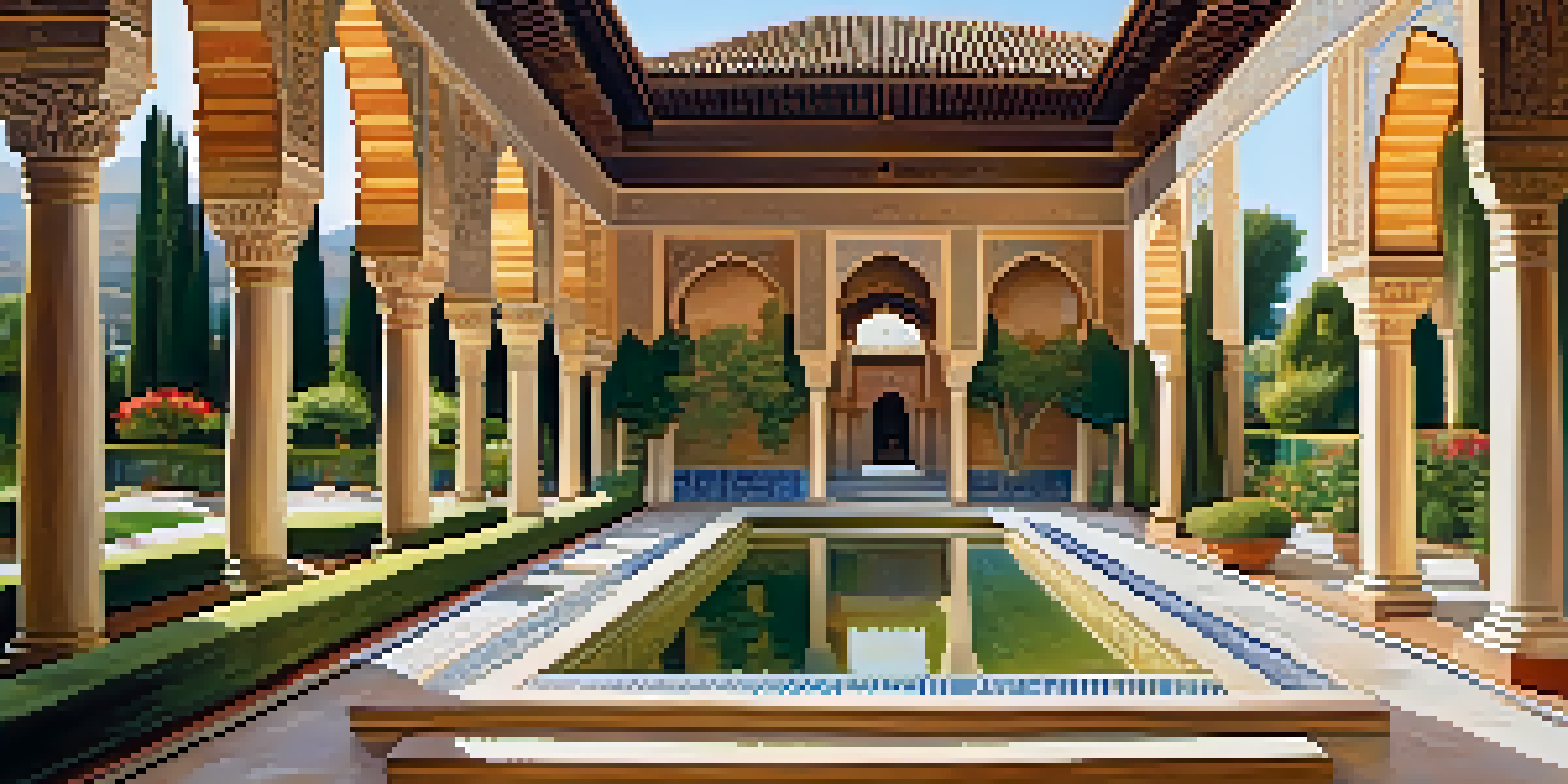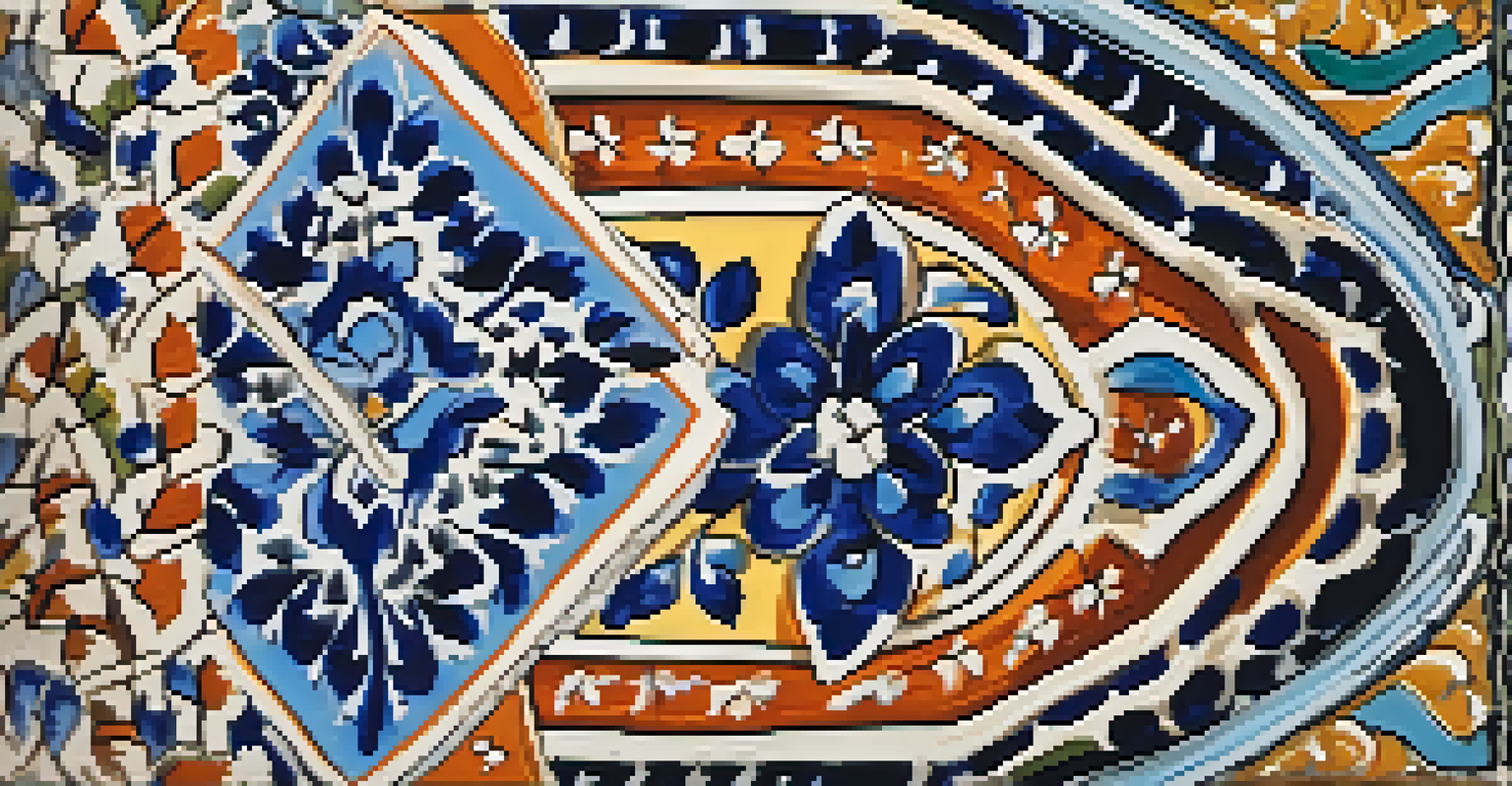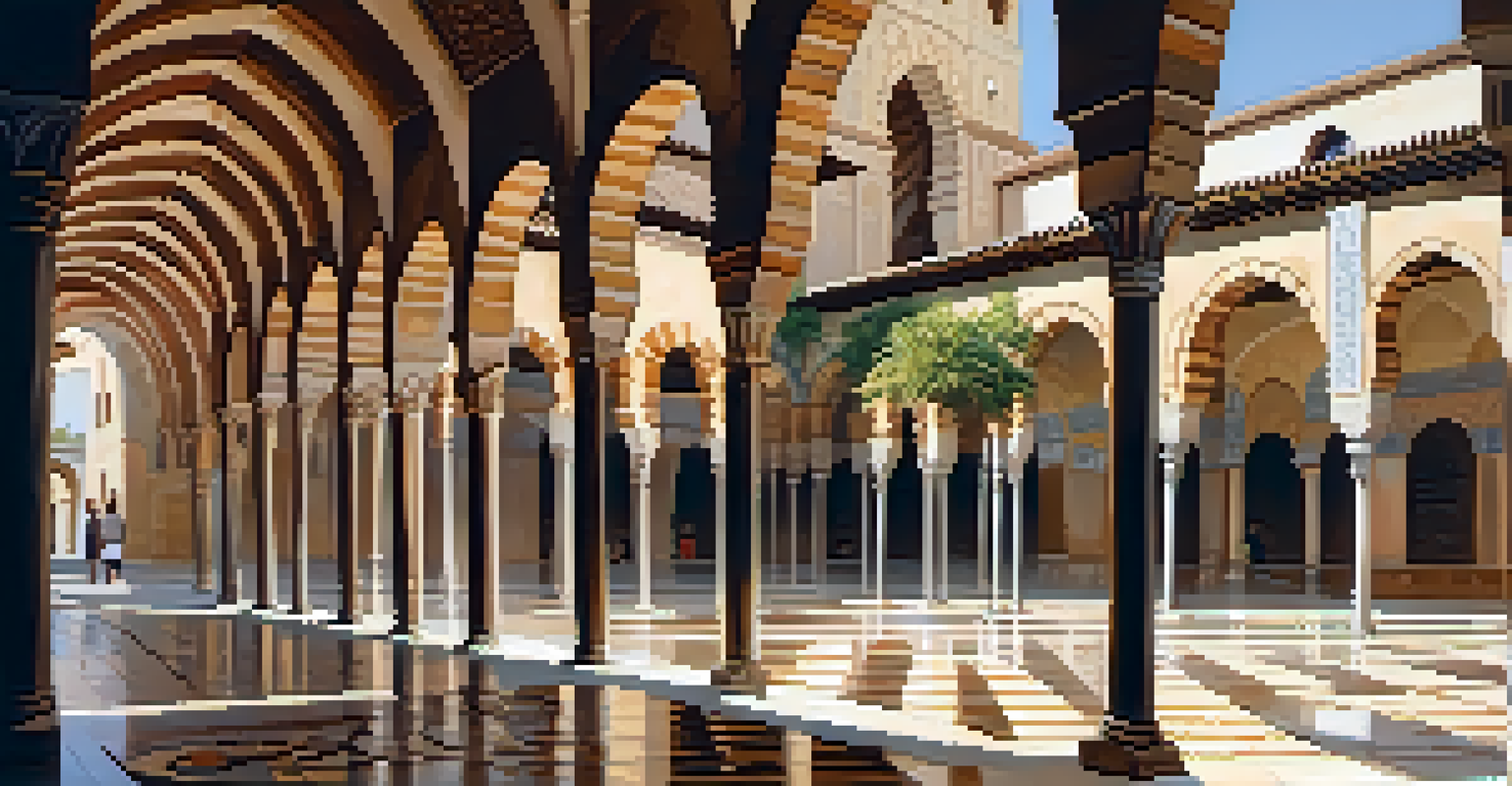Unveiling the Rich Heritage of Islamic Art in Spain's History

The Historical Roots of Islamic Art in Spain
Islamic art in Spain, especially during the period of Al-Andalus, reflects a fascinating blend of cultures that thrived from the 8th to the 15th century. This era began when the Umayyad Caliphate expanded into the Iberian Peninsula, introducing a rich tapestry of artistic expression. The resulting fusion of Islamic, Christian, and Jewish influences gave rise to a unique aesthetic that would leave a lasting mark on Spanish architecture and art.
Art is the most beautiful of all lies.
One of the most iconic examples of this heritage is the Great Mosque of Córdoba. Originally built as a place of worship, it showcases stunning horseshoe arches and intricate tile work that exemplify the beauty of Islamic design. Such structures were not merely functional; they were also reflections of the spiritual and cultural aspirations of the time.
As we delve deeper into Spain's history, it's essential to acknowledge how this artistic legacy shaped not only the visual landscape of Spain but also influenced broader European art movements. The interplay of different cultures in Islamic art invites us to appreciate the complexities of historical narratives.
Key Characteristics of Islamic Art
Islamic art is characterized by its intricate patterns, calligraphy, and a deep reverence for geometry. Unlike many Western art forms, it often avoids depicting human figures, focusing instead on abstract designs that convey beauty and spirituality. This unique approach stems from the Islamic belief in the oneness of God, which influences the artistic expression seen throughout this genre.

One of the most significant features of Islamic art is the use of arabesques—intertwining floral and geometric motifs that symbolize the infinite nature of creation. These designs can be found in everything from mosque decorations to textiles, showcasing an artistic language that transcends cultural boundaries. Each piece tells a story of devotion, creativity, and a deep-seated connection to the divine.
Islamic Art's Cultural Fusion
Islamic art in Spain exemplifies a unique blend of Islamic, Christian, and Jewish influences that shaped the region's artistic landscape.
Furthermore, calligraphy plays a pivotal role in Islamic art. Often considered the highest form of artistic expression, it transforms words into visual art. Artists meticulously craft verses from the Quran, making them central to the aesthetic experience of a piece, thereby merging beauty with spirituality.
The Alhambra: A Masterpiece of Islamic Architecture
The Alhambra in Granada stands as a stunning testament to the heights of Islamic art and architecture. Built during the Nasrid Dynasty, this palatial fortress complex is renowned for its breathtaking beauty and intricate details, making it one of the most visited monuments in Spain. Its architecture reflects a harmonious blend of artistry and functionality, showcasing the sophistication of Islamic design.
Every culture is a unique expression of the human experience, a mirror reflecting the values and aspirations of its people.
Visitors to the Alhambra are often captivated by its elaborate tile work, ornate plaster ceilings, and tranquil gardens. The Court of the Lions, for instance, features a striking fountain surrounded by twelve marble lions, symbolizing strength and protection. Such elements not only serve aesthetic purposes but also convey deeper cultural meanings, inviting contemplation and reflection.
The Alhambra's significance extends beyond its physical beauty; it embodies the cultural exchange that characterized the Iberian Peninsula during the medieval period. Each corner of this architectural marvel whispers stories of coexistence, creativity, and the enduring legacy of Islamic art in shaping Spain’s identity.
The Influence of Islamic Art on Spanish Culture
Islamic art has profoundly influenced various aspects of Spanish culture, from literature to music and beyond. The fusion of styles and ideas during the Al-Andalus period contributed to a rich cultural milieu. This blending of artistic traditions laid the groundwork for the Spanish Renaissance, which would see a resurgence of interest in the arts.
One notable example is the incorporation of Islamic motifs into Spanish ceramics, particularly in the famous Talavera pottery. The vibrant colors and intricate designs echo the aesthetics of Islamic art, illustrating the lasting impact of this heritage. These pieces not only serve functional purposes but also act as cultural artifacts that tell stories of a shared past.
Alhambra: Architectural Marvel
The Alhambra in Granada showcases the heights of Islamic architecture, reflecting both beauty and cultural significance through its intricate designs.
The musical traditions of Spain also reflect this Islamic influence. Instruments like the oud, which has roots in Islamic culture, have shaped the soundscape of Spanish folk music. This cross-cultural connection highlights how Islamic art has woven itself into the very fabric of Spanish identity, enriching it in diverse and unexpected ways.
Preservation and Appreciation of Islamic Art
Preserving the legacy of Islamic art in Spain is crucial for future generations to appreciate this rich heritage. Various organizations and museums are dedicated to protecting and showcasing these artistic treasures, ensuring that the cultural narratives they hold continue to inspire. From exhibitions to educational programs, efforts are being made to highlight the significance of Islamic art in Spain's history.
One such initiative is the Cordoba Mosque-Cathedral, where ongoing debates about its preservation and representation reflect the complexities of cultural identity. This site serves as a powerful reminder of the intertwined histories of Islam and Christianity in Spain, prompting discussions about inclusivity and shared heritage.
Moreover, local art and history festivals celebrate the contributions of Islamic art, fostering community engagement and awareness. By emphasizing the beauty and significance of this art form, we can cultivate a deeper understanding of our shared past and the diverse influences that have shaped contemporary Spanish culture.
Modern Interpretations of Islamic Art
In contemporary times, Islamic art continues to inspire and evolve, with modern artists drawing upon its rich traditions to create innovative works. These artists often blend classical techniques with modern themes, pushing the boundaries of how we perceive and engage with Islamic art today. This dynamic dialogue between past and present allows for a fresh appreciation of its aesthetics and cultural significance.
For instance, many Spanish artists incorporate traditional Islamic patterns into their modern works, reinterpreting these motifs in new contexts. This not only honors the historical legacy but also contributes to a vibrant contemporary art scene that reflects the multicultural nature of Spain. Such creative endeavors remind us that art is a living tradition, constantly reimagined and reshaped by new generations.
Modern Interpretations Thrive
Contemporary artists are reimagining Islamic art by blending traditional motifs with modern themes, highlighting its ongoing relevance in today's multicultural society.
Furthermore, exhibitions showcasing modern interpretations of Islamic art foster a deeper understanding of its relevance today. By bridging cultural gaps and inviting dialogue, these exhibitions serve as a testament to the enduring legacy of Islamic art in shaping our collective identity in an increasingly globalized world.
Conclusion: Embracing the Legacy of Islamic Art
The rich heritage of Islamic art in Spain is a testament to the enduring power of creativity and cultural exchange. From the stunning architecture of the Alhambra to the intricate patterns found in textiles and ceramics, this artistic legacy invites us to explore our shared history. Embracing this heritage allows us to celebrate the diverse influences that have shaped Spanish culture over centuries.
As we reflect on the significance of Islamic art, it becomes clear that it is not merely an aesthetic pursuit; it is a narrative woven into the very fabric of Spain's identity. Understanding this legacy enriches our appreciation of art and culture, reminding us that creativity knows no boundaries.

In celebrating the intertwined histories of Islamic and Spanish art, we foster a sense of unity and understanding that transcends cultural divides. By continuing to engage with and preserve this artistic heritage, we contribute to a more inclusive and harmonious future, where diverse narratives are celebrated and honored.